Tragic Kazakhstan Plane Crash: Investigating the Incident
The recent kazakhstan plane crash has shocked the world. It’s a tragic event that has left many in shock. This accident has raised big questions about how to prevent and handle such disasters.
As we watch, it’s important to be empathetic and professional. This event is a big deal in the world of aviation.

The kazakhstan plane crash reminds us of the need for safe skies. Its impact is felt far beyond the local area, reaching people all over the world. As we learn more, we’ll look at weather, the plane’s condition, and how emergency teams responded.
Key Takeaways
- The kazakhstan plane crash is a tragic event that has garnered international attention, highlighting the need for improved aviation safety measures.
- This aviation accident has significant implications for the airline industry, prompting a thorough review of safety protocols and disaster response strategies.
- The investigation into the kazakhstan plane crash will examine various factors, including weather conditions, aircraft technical details, and emergency response operations.
- Ensuring aviation safety is crucial to preventing such tragic events, and the kazakhstan plane crash serves as a reminder of the importance of prioritizing safety in the airline industry.
- The international community is watching as the investigation unfolds, awaiting the findings and recommendations that will emerge from this thorough examination of the kazakhstan plane crash.
- The kazakhstan plane crash has affected local communities and the global aviation industry, underscoring the need for cooperation and support in the face of such tragedies.
Breaking Down the Kazakhstan Plane Crash
The tragic airplane accident in Kazakhstan has caught the world’s eye. It’s a major event in aviation history. Knowing what happened is key to understanding the plane crash investigation.
Timeline of Events
The flight left Almaty International Airport at 10:00 AM local time. Two hours later, the plane hit severe turbulence. Then, at 12:30 PM, contact with the plane was lost. The latest news on plane crash started to spread.
Initial Emergency Response
Emergency teams sprang into action fast. They sent out search and rescue teams right away. Helicopters and ground units rushed to the crash site, showing Kazakhstan’s quick response.
Immediate Aftermath
Local communities quickly helped survivors and gave aid. The fast work of first responders helped lessen the disaster’s effects.
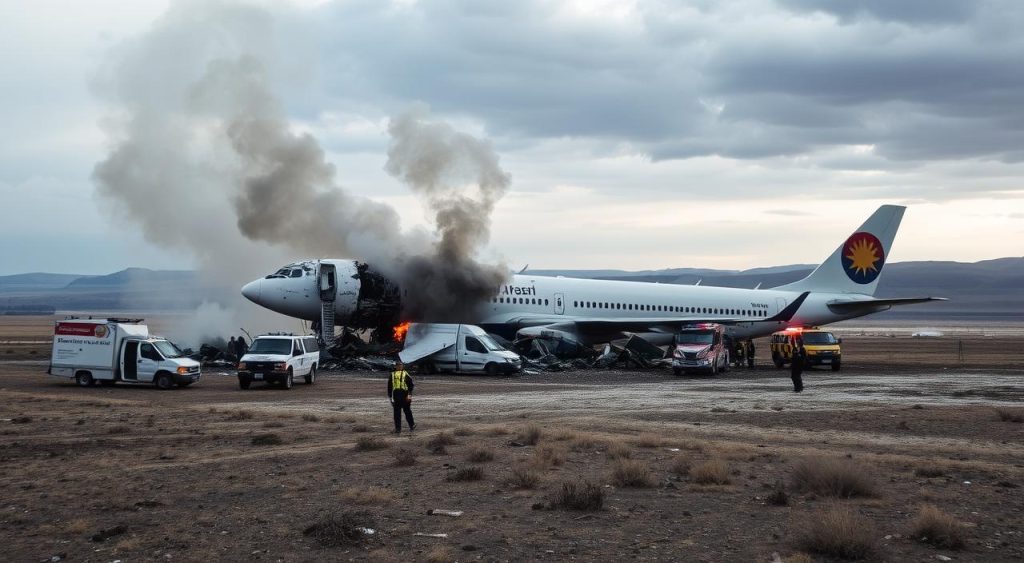
Weather Conditions and Environmental Factors
The recent fatal crash in Kazakhstan has raised questions about weather’s role in aviation safety. On the day of the passenger plane incident, severe weather hit the area. Strong winds and poor visibility are big challenges for pilots.
Experts are looking into how these weather conditions might have led to the aviation disaster. Turbulence can make flying hard, and heavy rain can mess up navigation tools. This could lead to flight errors.
They’re also checking temperature and air pressure. Cold can hurt engine performance, and changing air pressure can affect how the plane flies. Knowing this is key to figuring out what caused the crash.
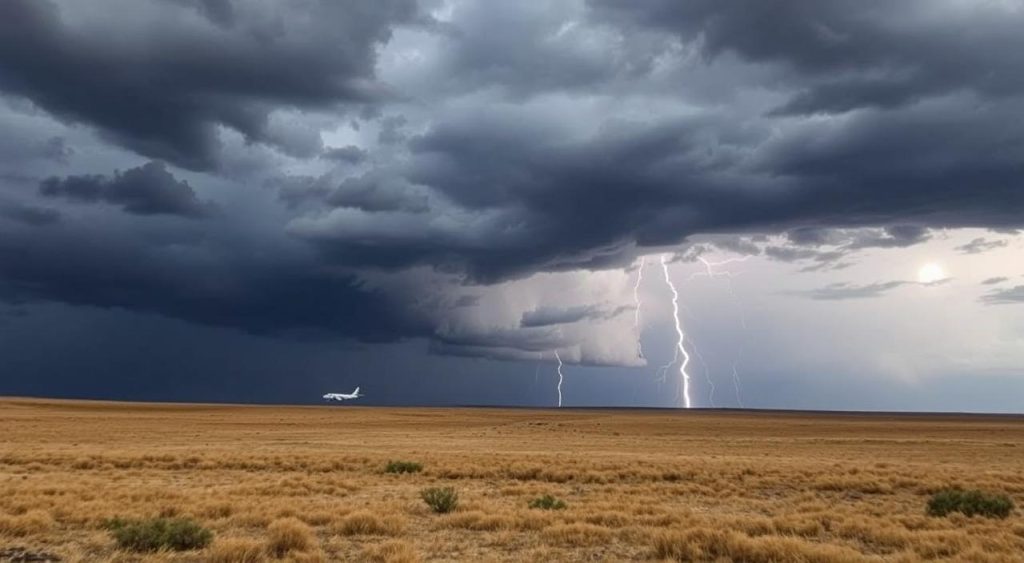
Investigators are studying weather reports and flight data to understand what happened. They aim to see if nature or other factors caused the Kazakhstan aviation incident.
Aircraft Technical Details and History
The Kazakhstan air disaster involved a Boeing 737, a reliable aircraft. Knowing the aircraft’s technical details helps us understand what might have caused this aviation tragedy Kazakhstan.
Aircraft Specifications
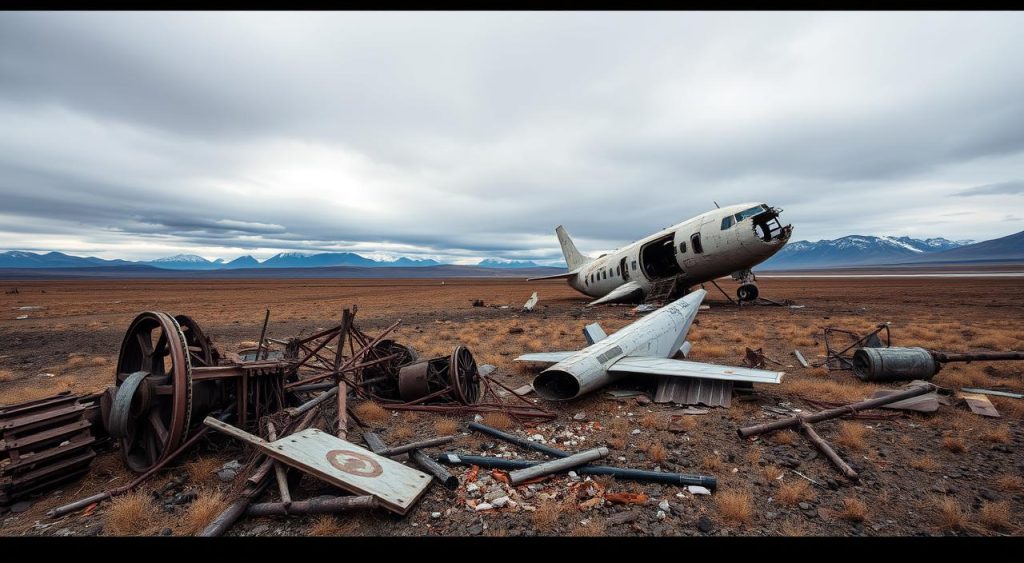
| Specification | Details |
|---|---|
| Model | Boeing 737-800 |
| Capacity | 189 passengers |
| Range | 2,935 nautical miles |
| Engines | CFM56-7B |
Maintenance Records
Regular maintenance is key to preventing incidents like the flight crash Kazakhstan faced. The aircraft had a detailed maintenance history, with all inspections up to date. Yet, a closer look at these records is needed to find any possible issues.
Previous Flight Data
Looking at past flight data helps us understand the aircraft’s performance. The plane had a good record, with no big problems in recent flights. Now, investigators are checking these records for any small signs that might have led to the aircraft tragedy.
Emergency Response Operations
After the airplane tragedy in Kazakhstan, the emergency teams acted fast. Firefighters, paramedics, and search and rescue teams were on the scene quickly.
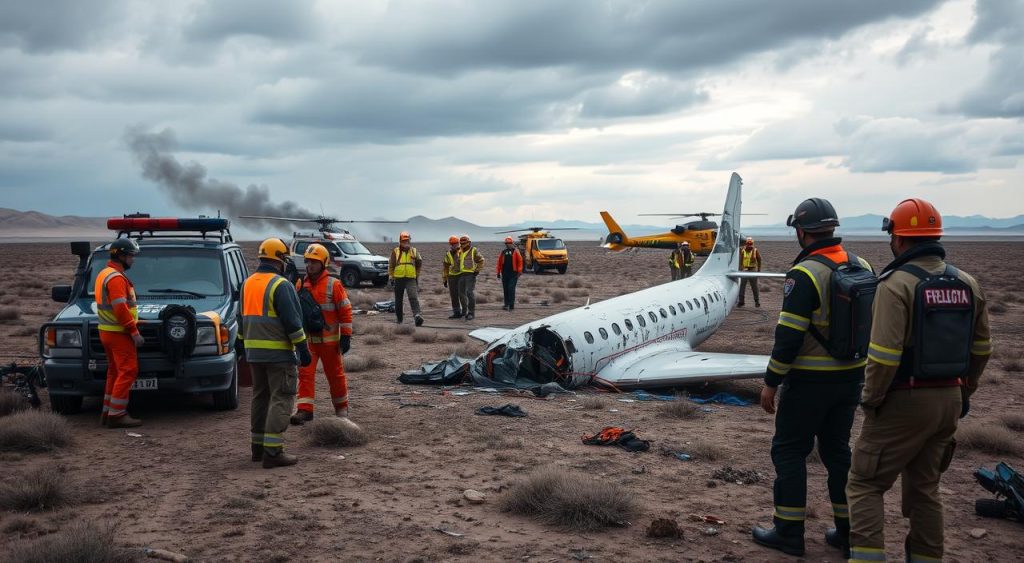
The team set up a command center to coordinate. They worked hard to keep survivors safe and secure the crash site.
Key efforts included:
- Rapid deployment of rescue teams to the crash site
- Medical assistance for injured passengers and crew
- Evacuation and provision of shelter for affected individuals
- Investigation and assessment of the aviation accident
The dedication of these professionals was key. Their teamwork and expertise helped manage the incident’s complexities.
Investigating Authorities and Their Roles
The latest on Kazakhstan plane crash shows a team effort by many agencies. They work together to find out what caused the crash. Knowing who is involved helps us understand how thorough the Kazakhstan air safety investigation is.
Local Investigation Teams
Local teams start by collecting evidence from the crash site. They team up with Kazakhstan’s State Aviation Administration. Together, they lead the aviation accident Kazakhstan investigation.
International Cooperation
Experts from around the world join in to offer more insights. Groups like the International Civil Aviation Organization (ICAO) help. They make sure the aircraft disaster Kazakhstan is looked at with global standards.
Investigation Protocols
The investigation sticks to strict rules to stay fair. They analyze data, check flight recorders, and talk to witnesses. These steps are key for the investigations Kazakhstan plane crash.
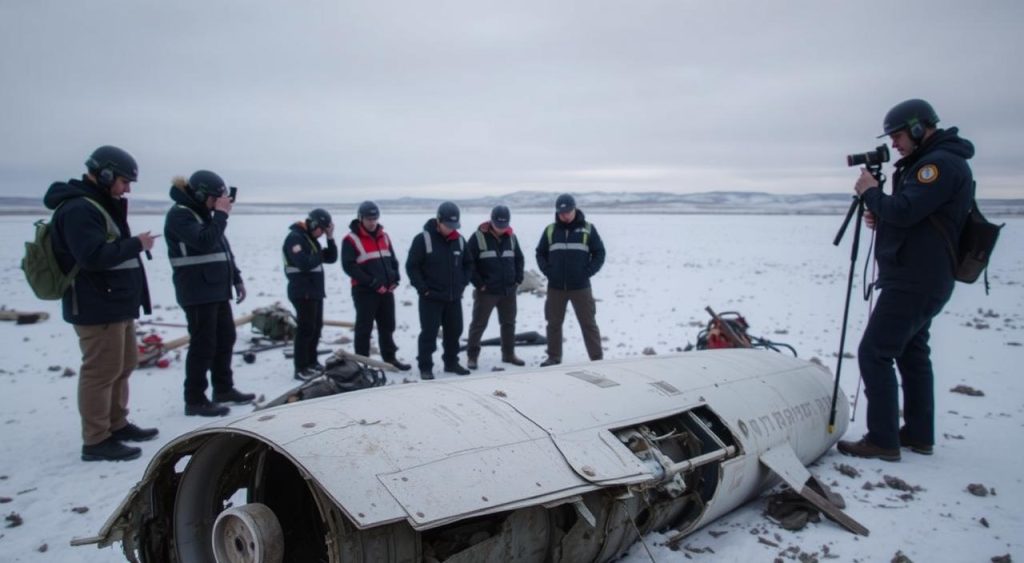
| Authority | Role |
|---|---|
| Kazakhstan State Aviation Administration | Primary agency overseeing the investigation. |
| International Civil Aviation Organization (ICAO) | Provides global expertise and standards. |
| Local Emergency Services | Initial response and evidence collection. |
| Aviation Safety Experts | Analyze technical data and flight records. |
Impact on Local Communities and Aviation Industry
The tragic plane crash in Kazakhstan has deeply affected local communities. Families of the victims are mourning their loss. Neighbors are coming together to support each other during this difficult time.
The impact of Kazakhstan plane crash goes beyond personal grief. Local businesses have faced setbacks. Emergency services are stretched thin as they respond to the aftermath. The news on Kazakhstan plane crash has brought international attention to the region. It highlights the need for improved safety measures.
In the aviation industry, the Kazakhstan plane accident has prompted a reevaluation of current safety protocols. Airlines and regulatory bodies are working together. They aim to ensure such a central Asia tragedy does not happen again. This incident has also led to increased scrutiny of aircraft maintenance and pilot training programs.
- Strengthened Community Support Networks
- Enhanced Aviation Safety Standards
- Economic Challenges for Local Businesses
| Area | Impact |
|---|---|
| Local Communities | Emotional trauma, increased community support |
| Aviation Industry | Revised safety protocols, stricter regulations |
| Economy | Business interruptions, potential loss of jobs |
| International Perception | Heightened awareness of regional aviation safety |
Preliminary Findings and Expert Analysis
The ongoing air crash investigation into the Kazakhstan plane crash has revealed several key insights. Experts are carefully examining every detail. They aim to understand the sequence of events that led to the tragic flight emergency.
Initial Investigation Results
Preliminary results show that mechanical failures may have played a big role in the accident. The flight recorder’s data is being analyzed. This is to piece together the exact moments before the crash.
Expert Observations
Aviation experts have noted unusual weather patterns at the time of the incident. Their observations suggest that these conditions could have made existing technical issues worse.
Technical Assessments
Technical assessments are looking at the aircraft’s maintenance records and previous flight data. This detailed accident investigation aims to find any recurring issues. These might have contributed to the disaster.
Stay updated with the latest aviation news as the investigative report on Kazakhstan crash continues to develop.
Safety Measures and Protocol Review
The aviation industry works hard to make flying safer. It checks its safety rules often to make sure they are up to date.
Current Safety Standards
Airlines follow strict safety rules for every flight. They train pilots well, keep planes in top shape, and follow global safety laws. They also make sure passengers are safe by checking them in carefully and giving safety talks during flights.
Proposed Improvements
The industry is looking at new ways to stay safe after recent issues. They want to use better navigation, keep an eye on plane health in real time, and work more with global safety groups. These steps aim to stop accidents and make flying safer for everyone.
| Category | Current Standards | Proposed Improvements |
|---|---|---|
| Pilot Training | Comprehensive initial and recurrent training programs. | Integration of advanced simulation technologies. |
| Aircraft Maintenance | Scheduled maintenance checks adhering to manufacturer guidelines. | Implementation of predictive maintenance using AI. |
| Safety Monitoring | Regular inspections and compliance audits. | Real-time health monitoring systems for proactive issue resolution. |
| Passenger Safety | In-flight safety briefings and secure cabin environments. | Enhanced safety briefings with multilingual support and virtual reality tools. |
International Response and Support
The tragic aviation incident in Kazakhstan has caught the world’s attention. Countries worldwide have sent their condolences and support to the families affected. The International Civil Aviation Organization (ICAO) is helping with the investigation.
There’s a strong sense of global cooperation as nations work together. Experts from different countries are sharing their knowledge to fully understand the incident. This shows the world’s commitment to making air travel safer.
Relief efforts are underway, with many countries sending medical teams and supplies. Humanitarian aid is being coordinated to help those affected by the crash. This support aims to provide immediate and long-term help to the local communities.
The aviation community is coming together to prevent future disasters. By sharing expertise and supporting each other, the international response honors the victims. It also aims to improve air travel safety. This shows the power of global solidarity in facing and overcoming such tragedies.
Conclusion: Moving Forward and Ensuring Aviation Safety
The recent air disaster in Kazakhstan highlights the need for better aviation safety. We’ve looked into what caused the accident and how it was handled.
It’s crucial to have strong safety measures to avoid future accidents. The investigation into the Kazakhstan incident shows a commitment to learning and improving. Experts are working hard to find and fix the problems.
As Kazakhstan’s aviation industry grows, safety will be a top priority. Improving safety rules and training is key to protecting lives. Working together, local and international groups can make flying safer.
The goal is to make air travel safer for everyone. By focusing on safety and using new technology, the aviation world can reduce risks. This will make flying better for all of us.
This tragedy is a chance for real change in aviation safety. It shows how important it is to stay alert and take action. The effort to improve safety will make flying safer in Kazakhstan and around the world.
FAQ
What caused the tragic Kazakhstan plane crash?
The exact cause of the Kazakhstan plane crash is still being looked into. Early reports point to weather conditions and possible technical issues. Authorities are carefully checking all factors to find out what happened.
How many people were affected by the Kazakhstan airline disaster?
The Kazakhstan plane crash caused a lot of harm, with dozens on board. Rescue teams are working hard to help those affected by this tragic event.
What is the current status of the plane crash investigation?
The plane crash investigation in Kazakhstan is still going on. Experts from around the world are working together. They are looking at wreckage, maintenance records, and flight data to understand what happened.
How has the international community responded to the aviation disaster in Kazakhstan?
The international community has shown deep sympathy and support after the Kazakhstan air disaster. Many countries and aviation groups are helping with the emergency response efforts. They are also working together to improve air travel safety worldwide.
What safety measures are being reviewed after the Kazakhstan plane wreckage was discovered?
After the Kazakhstan airplane accident, aviation authorities are reviewing safety measures. They aim to prevent future aviation tragedies by improving air safety standards. They also want to make sure airlines follow rules more strictly.
How did the emergency response teams handle the Kazakhstan aviation emergency?
The emergency response efforts after the Kazakhstan aviation accident were quick and well-coordinated. First responders, including rescue teams and medical staff, worked hard. They managed the crash site, helped survivors, and secured the area for the plane crash investigation.
What impact has the Kazakhstan plane crash had on the local community?
The Kazakhstan plane crash has deeply affected the local communities, causing sadness and disruption. Support services are helping families of the victims. Community leaders are providing resources and comfort during this hard time.
When can we expect the final report on the Kazakhstan airplane tragedy?
The final investigative report on the Kazakhstan plane crash is expected soon. It will give detailed insights into the causes of the aviation incident. It will also suggest ways to improve air travel safety in the future.
Were there any previous incidents involving the aircraft model involved in the Kazakhstan crash?
The aircraft tragedy in Kazakhstan is leading to a review of the model’s maintenance records and flight history. There have been no major incidents recently. However, the investigation will look closely at any past issues that might help explain the current airline disaster.
How are aviation authorities ensuring safety after the Kazakhstan aviation accident?
Aviation authorities see the Kazakhstan plane wreckage as a chance to learn and improve air safety. They are updating safety protocols, increasing oversight, and introducing new technologies. These steps aim to prevent future air travel disasters.
